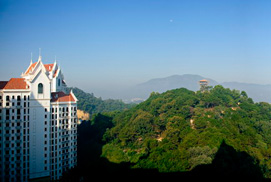建筑的阴与阳
古老的中国学者相信整个宇宙是由两种自然的、完全相反的力量所构成的:阴和阳。阴阳学说是研究关于这两种相对能量以及它们之间存在的关系。阴代表着女性、反面、黑暗、温柔、潮湿和黑夜,而阳代表男性、正面、坚硬、干燥和白日。纯粹100%的阴和阳都是不存在的。在每件事物中,都不同程度地包含其对立面的特性。阴阳之间的差异越大,则它们之间的吸引力就越强。当阴阳之间持续地斗争达到平衡和和谐的时候,这本质相对立的两极对抗作用已经不存在了。它们总是相融共生的。任何一方总是孕育、支持和控制着另外一方。当一方运动,则另外一方也跟着运动。黑夜与白天,冬天和夏季,女人与男人是这个自然世界中阴和阳存在的基础。自然界处于一种正常、效率与持续的存在状态完全是靠这两者的不断地相互作用和提高。
在一个好的设计之中,处处都包含了阴阳的平衡和和谐。建筑设计本身也充满了阴阳的法则。建筑物的设计和功能布局可以理解为一个美观实用与对立统一的阴阳平衡系统。从阴阳学的角度,功能布局中的相互关系可以理解为公共空间与私密空间、室内空间与室外空间的处理。
从一个设计师的角度,我们能看到阴和阳的体现在于:用光影区别深度和形状,用虚实限定空间,还有天然材料和人造材料的对比运用,曲和直的对比,垂直和水平的对比等等。
结构本身也依靠阴阳关系而存在。工程师关于结构承重的要求与自然作用力之间也是阴阳系统的关系。当建筑物向上不断建高的同时,也不断受到地心的吸引力的作用。当它建到一定的高度,也会有一种力量反作用于建筑的基础。这些自然的作用力通过工程原理来克服以确保整个建筑物的力量均衡从而矗立不倒。减少或增加任何一种力量都可能导致整个结构的崩溃。不论什么时候产生一种力,那么就会有另一种力量来进行平衡。通过阴和阳的作用将动力维持在一种动态平衡及和谐的状态,这可以用一种戏剧性的词语来表达,使整个建筑物达到艺术美和动感个性的和谐统一。
The Yin Yang of Architecture
Ancient Chinese scholars believed that the universe consists of two natural, complementary yet contradictory forces: Yin and Yang. The study of Yin and Yang is concerned with the differentiation of these two opposing energies, and the relationships which exist between them. Yin represents the female, negative, darkness, softness, moisture, and night, and Yang represents the male, positive, brightness, hardness, dryness, and daytime. Pure Yin or Yang does not exist. In everything, there is always some degree of its opposite, its compliment. The greater the difference between Yin and Yang, the stronger the attractive force between them. While Yin and Yang are in a continual struggle for balance and harmony, there exists no antagonism between these two opposite poles of nature. They are always complimentary. Each serves to nourish, sustain and control the other. As one moves, the other responds accordingly. Night and day, winter and summer, woman and man are evidence of the existence of Yin and Yang in the natural world. The very existence of Nature in a normal, functional, and continual state depends upon the constant interaction and mutual enhancement of these two opposing energies.
The natural state of Yin and Yang, balance and harmony, is evident everywhere in good design. Architectural design itself is infused with Yin/Yang principles. Design and functionality of a building can be considered a Yin/Yang system with regards to beauty versus utility. Yin/Yang functional aspects can be considered with regards to public verses private spaces and indoor verses outdoor. From a design perspective, we can see Yin and Yang in the interplay of shadow and light distinguishing depth and shape, form and void in defining spaces, natural verses manufactured materials, the straight verses the curved, and the horizontal versus the vertical. The structure itself depends on Ying and Yang for its very existence. The engineering required for creating structures, the opposing of natural forces, is a Yin/Yang system. As buildings are constructed upward, there is a natural opposing force in the downward direction. As it rises higher, there is also a natural force pushing outward at the base of the building. These natural forces are counteracted through the use of engineering principles, which create an inward and upward force in order to cause the building to stand. Remove or increase any one of these forces and the entire structure will collapse. Whenever a force is resisted, it gives evidence of an equal and opposing force. This dramatic expression of dynamic mechanical forces held in a frozen state of balance and harmony through the forces of Yin and Yang creates an aesthetic beauty and vibrant character through out the entire building.
  |
